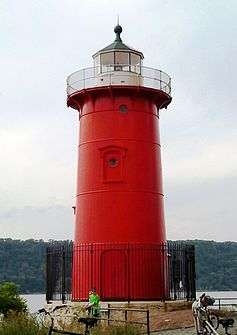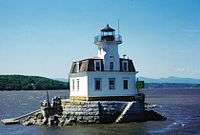Little Red Lighthouse
The Little Red Lighthouse, officially Jeffrey's Hook Light, is a small lighthouse located in Fort Washington Park along the Hudson River in Manhattan, New York City, under the George Washington Bridge. It was made notable by the 1942 children's book The Little Red Lighthouse and the Great Gray Bridge by Hildegarde Swift, illustrated by Lynd Ward. The lighthouse stands on Jeffrey's Hook, a small point of land that supports the base of the eastern pier of the bridge, which connects Washington Heights, Manhattan, to Fort Lee, New Jersey.
 (2012) | |

| |
| Location | Hudson River at Jeffrey's Hook in Fort Washington Park Washington Heights, Manhattan, New York City |
|---|---|
| Coordinates | 40°51′1″N 73°56′49″W |
| Year first constructed | 1889 |
| Year first lit | 1921 (current tower) |
| Deactivated | 1947–2002 |
| Foundation | concrete |
| Construction | cast iron |
| Tower shape | conical |
| Markings / pattern | red with white lantern |
| Tower height | 40 feet (12 m) |
| Current lens | 12 inches (300 mm) |
| Characteristic | Fl Red, 3s |
| ARLHS number | USA-408 |
| USCG number | 1-37668[1][2][3] |
| Heritage | New York City Landmark, place listed on the National Register of Historic Places |
Jeffrey's Hook Lighthouse | |
| Built | 1920 |
| MPS | Hudson River Lighthouses TR |
| NRHP reference No. | 79003130[4] |
| Significant dates | |
| Added to NRHP | May 29, 1979 |
| Designated NYCL | May 14, 1991 |
History
The first attempt to reduce Hudson River traffic accidents at Jeffrey's Hook was a red pole which was hung out over the river.[5] A 10 candle-power light was added to the pole in 1889 to help warn the increasing river traffic away from the spit of land at night. The land around Jeffrey's Hook was acquired by the city in 1896, and later become Fort Washington Park.[5]
The current structure was built as the North Hook Beacon at Sandy Hook, New Jersey, where it stood until 1917, when it became obsolete.[5] It was reconstructed at its current location in 1921 by the United States Lighthouse Establishment as part of a project to improve Hudson River navigational aids, and originally had a battery-powered lamp and a fog bell. It was operated by a part-time lighthouse keeper.[5]
Construction on the George Washington Bridge, immediately above the lighthouse, started in 1927.[6] When the George Washington Bridge was completed in 1931,[7] the lighthouse was considered to be obsoleted by the bridge's navigational lights,[8] and the Coast Guard decommissioned it and put out its light in 1948, with the intention of auctioning it off.[5] The proposed dismantling of the lighthouse resulted in a public outcry, largely from children who were fans of the 1942 children's book, The Little Red Lighthouse and the Great Gray Bridge, by Hildegarde Swift.[9] This led to the Coast Guard deeding the lighthouse to the New York City Department of Parks and Recreation on July 23, 1951.[5]
The lighthouse was listed on the National Register of Historic Places as "Jeffrey's Hook Lighthouse" in 1979,[10] and was designated a New York City Landmark in 1991.[5] In 2002, it was relighted by the city.[3]
Access
Public access to the lighthouse is by the Hudson River Greenway, reachable north of the George Washington Bridge by a footbridge across the Henry Hudson Parkway at West 182nd Street and Riverside Drive, and south of the bridge by a footbridge at West 158th Street. The northern path is very steep immediately north of the bridge, while the southern path is flat. There is also a very obscure pedestrian underpass at Riverside Drive parallel to 177th Street, just south of the George Washington Bridge. It empties out on the other side of the Henry Hudson Parkway and it's a dirth path down to the lighthouse. Tours of the lighthouse are given on an infrequent basis, arranged by the Parks Department's Urban Park Rangers, especially on the Little Red Lighthouse Festival day in late-September and Open House New York day in October.
The Little Red Lighthouse and the Great Gray Bridge

Published in 1942, this children's book uses the story of the building of the George Washington Bridge next to the small lighthouse to affirm the idea that even the small are important. The book begins by introducing the lighthouse. Every night a man climbs up to the top of the lighthouse and uses some keys to turn on its flashing light, allowing it to do its job of warning the boats on the busy Hudson River of the rocks nearby. When there is fog, the man additionally turns on the lighthouse's fog bell. The lighthouse is pleased with and proud of its important job.[10][11]
In the middle section of the book, the lighthouse watches, mystified, as men build a great gray bridge right next to it. When the bridge is finished, it towers above the lighthouse, making it now feel very small and unimportant. Then one night, a light begins to flash atop the bridge's tower, and the lighthouse becomes convinced that it is no longer needed. Even worse, as the night continues on, the man does not come to activate the lighthouse, and it fears it truly will never shine again.
Meanwhile, a storm whips up on the river and a thick fog clutches at the boats, but none of them can see the flashing light high atop the bridge, and without the lighthouse's light or bell, the "fat black tug" crashes upon the rocks nearby. The bridge calls to the lighthouse saying that its light is for aircraft, and reassures it that it is still needed, "each to his own place." The man finally arrives, in a rush and complaining about his being late was due to some boys stealing his keys. The lighthouse resumes its job, warning the boats throughout the storm and fog, and glad it still has work to do. Though it now knows that it is small, it is still very proud.
The book ends by encouraging the reader to go to Riverside Drive in New York City and "see for yourself" the lighthouse next to the bridge. The "great gray bridge" is clearly the George Washington Bridge, though it is not named in the book.
See also
- List of New York City Landmarks
- National Register of Historic Places listings in New York County, New York
References
- Light List, Volume I, Atlantic Coast, St. Croix River, Maine to Shrewsbury River, New Jersey (PDF). Light List. United States Coast Guard. 2009. p. 312.
- "Historic Light Station Information and Photography: New York". United States Coast Guard Historian's Office. Archived from the original on 2017-05-01.
- Rowlett, Russ (2009-12-28). "Lighthouses of the United States: Downstate New York". The Lighthouse Directory. University of North Carolina at Chapel Hill.
- "National Register Information System". National Register of Historic Places. National Park Service. March 13, 2009.
- New York City Department of Parks and Recreation. Historic plaque on the lighthouse
- "GROUND IS BROKEN FOR HUDSON BRIDGE; Acting Mayor McKee Digs Earth at 178th Street, Mayor White on New Jersey Shore. PLANES SOAR OVER RIVER Governors of Both States Heard by Radio on Both Banks From Steamer in Hudson. SEE FRIENDSHIP CEMENTED Smith Says Span Will Increase Prosperity -- Moore Calls It Monument to Progressive Spirit". The New York Times. September 22, 1927. ISSN 0362-4331. Retrieved June 5, 2018.
- "Two Governors Open Great Hudson Bridge As Throngs Look On". The New York Times. October 25, 1931. ISSN 0362-4331. Retrieved March 6, 2010.
- White, Norval; Willensky, Elliot & Leadon, Fran (2010). AIA Guide to New York City (5th ed.). New York: Oxford University Press. p. 570. ISBN 978-0-19538-386-7.
- New York City Landmarks Preservation Commission; Dolkart, Andrew S.; Postal, Matthew A. (2009). Postal, Matthew A. (ed.). Guide to New York City Landmarks (4th ed.). New York: John Wiley & Sons. ISBN 978-0-470-28963-1., p.213
- "Little Red Lighthouse" Archived 2010-12-30 at the Wayback Machine, Washington Heights & Inwood Online, NYC Dept. of Parks & Recreation, August 2001, accessed February 27, 2012
- Swift, Hildegarde (1942). The Little Red Lighthouse and the Great Gray Bridge. Lynd Ward (illustrator). Harcourt, Brace, and World. The 2002 edition is ISBN 0-15-204571-6
External links
| Wikimedia Commons has media related to Little Red Lighthouse. |


